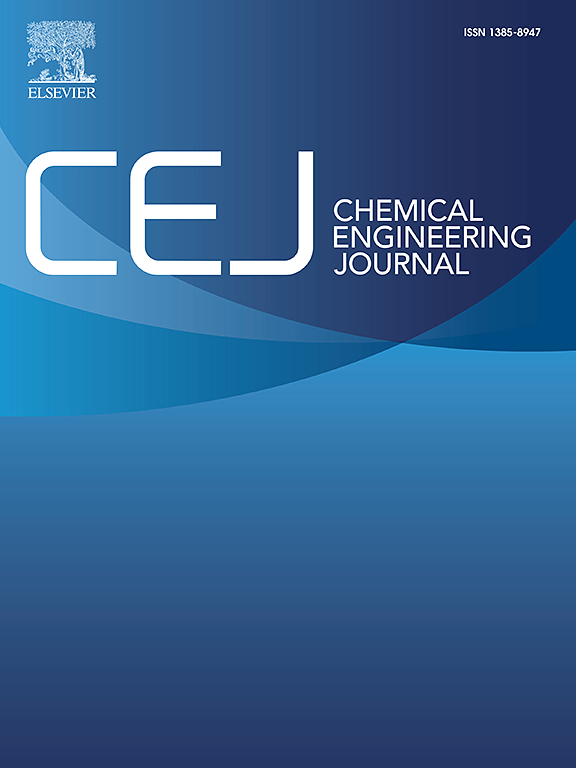Regulating three-dimensional morphology and surface functionality of cu/Cu2+1O@PANI electreocatalyst enables the conversion of nitrate to ammonia
IF 13.2
1区 工程技术
Q1 ENGINEERING, CHEMICAL
引用次数: 0
Abstract
The electrocatalytic nitrate reduction reaction (NO3RR) offers substantial potential for ammonia energy storage and conversion. However, the low adsorption capacity of nitrate and the key competition between hydrogen evolution reaction and NO3RR suppress the electrocatalytic reduction of NO3− to NH3. Here, we develop a novel Cu/Cu2+1O@PANI electrocatalyst by coupling nitrate-selective electrosorption material (polyaniline, PANI) with CuO inverse opals (CuO IOs) through in-situ electroreduction. The synergy of three-dimensional morphology and PANI functionality optimizes nitrate enrichment and activates hydrogen (*H) accumulation. Thanks to these advantages, the optimized Cu/Cu2+1O@PANI exhibits excellent NO3RR performance with a Faradaic efficiency (FE) of 90.89% and a maximum NH3 yield of 0.2846 mmol h−1 cm−2. Finite element analysis (FEA) and density functional theory (DFT) calculations reveal that the 3D porous structure enhances the local concentration of NO3−, whilst the functional interface of Cu/Cu2+1O@PANI promotes the generation of *H and facilitates the formation of reaction intermediates (*NOH), thereby ensuring improved reaction selectivity.

调节cu/Cu2+1O@PANI电催化剂的三维形态和表面功能使硝酸盐转化为氨
电催化硝酸还原反应(NO3RR)为氨能量储存和转化提供了巨大的潜力。然而,硝酸盐的低吸附能力和析氢反应与NO3RR的激烈竞争抑制了NO3−电催化还原为NH3。本研究通过原位电还原将硝酸选择性电吸附材料(聚苯胺,PANI)与CuO逆蛋白石(CuO IOs)偶联,开发了一种新型Cu/Cu2+1O@PANI电催化剂。三维形态和聚苯胺功能的协同作用优化了硝酸盐的富集并激活了氢(*H)的积累。由于这些优点,优化后的Cu/Cu2+1O@PANI具有优异的NO3RR性能,其法拉第效率(FE)为90.89%,NH3产率最高为0.2846 mmol h−1 cm−2。有限元分析(FEA)和密度泛函理论(DFT)计算表明,三维多孔结构增强了NO3−的局部浓度,而Cu/Cu2+1O@PANI的功能界面促进了*H的生成,促进了反应中间体(*NOH)的形成,从而保证了反应选择性的提高。
本文章由计算机程序翻译,如有差异,请以英文原文为准。
求助全文
约1分钟内获得全文
求助全文
来源期刊

Chemical Engineering Journal
工程技术-工程:化工
CiteScore
21.70
自引率
9.30%
发文量
6781
审稿时长
2.4 months
期刊介绍:
The Chemical Engineering Journal is an international research journal that invites contributions of original and novel fundamental research. It aims to provide an international platform for presenting original fundamental research, interpretative reviews, and discussions on new developments in chemical engineering. The journal welcomes papers that describe novel theory and its practical application, as well as those that demonstrate the transfer of techniques from other disciplines. It also welcomes reports on carefully conducted experimental work that is soundly interpreted. The main focus of the journal is on original and rigorous research results that have broad significance. The Catalysis section within the Chemical Engineering Journal focuses specifically on Experimental and Theoretical studies in the fields of heterogeneous catalysis, molecular catalysis, and biocatalysis. These studies have industrial impact on various sectors such as chemicals, energy, materials, foods, healthcare, and environmental protection.
 求助内容:
求助内容: 应助结果提醒方式:
应助结果提醒方式:


